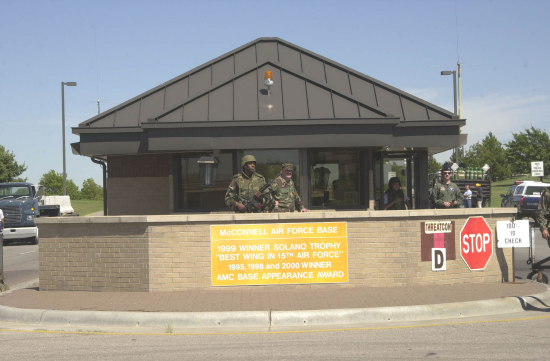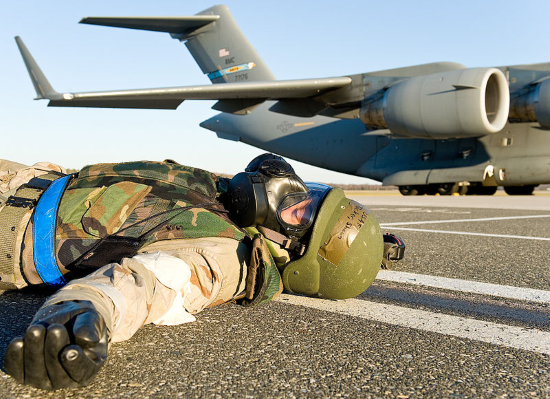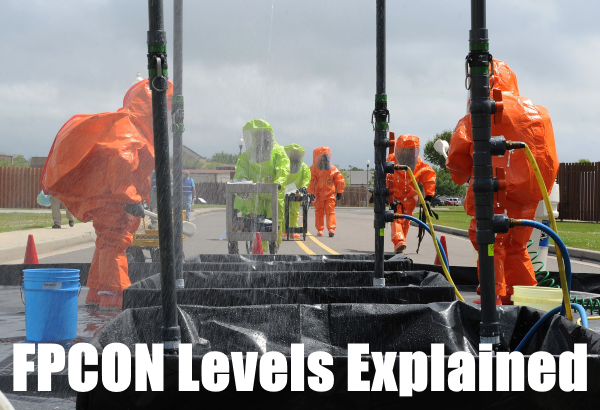Force Protection Levels, also known as FPCON, play an important role for the Department of Defense (DoD).
The threat awareness system (formerly known as THREATCON) defines levels of danger/threats targeted toward military bases and operations.
Consequently, Force Protection Levels (FPCON) forewarn the U.S. Armed Forces against impending danger.
More importantly, it keeps our nation safe and secure from terrorist threats.
Learn more about the 5 Force Protection Condition Levels (FPCON) that exist under current Department of Defense guidelines.
Table of Contents
What are the Force Protection Levels (FPCON)?

Force Protection Conditions Levels (FPCON) are utilized by the U.S. Armed Forces.
The Department of Defense (DoD) implemented FPCON as a threat awareness system.
Therefore, force protection levels notify military bases and operations of terrorist threats.
Force protection levels are assigned to “non-targeted” conditions and general threats.
In other words, the force protection levels in the system are not linear and therefore do not progress in sequential order.
Rather, the FPCON status is designated and implemented when conditions warrant.
FPCON Levels
In general, FPCON Normal is the lowest/safest status of the force protection levels.
Meanwhile, the highest threat level (FPCON DELTA) is a serious danger to national security.
FPCON DELTA is the only status that may refer to a specific known threat under the force protection levels.
Force Protection Condition Levels (FPCON) were formerly referred to by the military as THREATCON.
It’s important to note that FPCON is not the same as the DEFCON awareness system.
DEFCON focuses on threats to the United States while FPCON monitors threats to military installations and operations.
For this reason, multiple FPCON levels exist depending on the base and its location, or military operation and variables.
Moreover, Force Protection Condition Levels can change rapidly depending on circumstances surrounding the base/operation.
FPCON Command
The commander of the U.S. Northern Command determines the minimum force protection level for every military base in the United States.
USNORTHCOM establishes the force protection levels for many other military installations in North America.
Meanwhile, the U.S. European Command and U.S. Southern Command are responsible for their regions of responsibility.
The Department of Defense enables individual military bases to increase force protection levels.
Nevertheless, all military installations must adhere to the minimum FPCON level determined by USNORTHCOM.
Those seeking to find the latest FPCON conditions for any U.S. military base should check the official website.
Additionally, visitors can find the latest Force Protection Condition Levels (FPCON) at each gate entrance.
5 Force Protection Levels (FPCON)

The Department of Defense (DoD) assigns 5 force protection levels for military bases and operations.
These force protection levels are enforced for military installations in the United States as well as around the world.
USNORTHCOM enforces the FPCON levels to confirm military bases are taking the appropriate measures to remain safe.
Thus, it’s crucial to understand each FPCON level and what it entails for security purposes:
#1. FPCON Normal
FPCON Normal, as the name implies, indicates standard/normal activity.
As a result, FPCON Normal is the lowest of the force protection levels in terms of danger/security risk.
The Department of Defense generally assigns FPCON Normal during peacetime.
It describes a situation of no perceived global or terrorist threat with routine security warranted.
Thus, no security concern is expected yet personnel should always remain vigilant.
The DoD traditionally posts a green FPCON Normal icon to notify military personnel and visitors at gated entrances.
Consequently, U.S. Armed Forces enforce FPCON Normal by conducting ID checks and security sweeps at these gates.
There are situations when force protection levels are upgraded to an enhancement status (+).
The enhancement status indicator designates that further safety measures may be required than the standard guidelines of the FPCON.
#2. FPCON ALPHA
FPCON Alpha indicates minor but unpredictable terrorism threats.
It’s the next status up from FPCON Normal in terms of a perceived threat/danger level to military base security.
In general, there is an overall threat of violence in the region but nothing that indicates the base/operation is compromised.
Nonetheless, FPCON Alpha demands a few more security measures to implement at bases.
Thus, military personnel may enforce random ID checks, vehicle searches, or other safety measures.
Those visiting a military base will notice an orange FPCON Alpha sign at gated entrances to indicate this force protection level.
Those stationed at the military installation are usually instructed to notify family members of the increase in FPCON.
Therefore, military personnel should remain alert and report any suspicious activities immediately to security forces.
FPCON Alpha+ is a security enhancement often seen to increase procedures from the standard protocol (yet prevents jumping to the next level, FPCON Bravo).
#3. FPCON BRAVO
FPCON Bravo describes a situation with a somewhat predictable threat of terrorist activity.
The key word is “predictable” as probable violence may occur in the area.
However, nothing indicates that the violence is directly connected or targeted toward the military installation.
FPCON Bravo requires extra precautions for military personnel to deter future terrorist activity.
The security measures taken by the military base may impact the activities of local law enforcement as well as the general public.
Thus, FPCON Bravo generally requires stricter inspections of vehicles and deliveries.
Moreover, military checkpoints may demand ID checks and vehicle searches.
The presence of more guards will include patrols to verify the safety of the military establishment.
The DoD informs military personnel of FPCON Bravo with a blue sign posted at entrances and doorways.
Military families traditionally receive updates when a military base is increased to FPCON Bravo.
It’s important to keep cars and objects away from buildings to help security forces clear the area.
Finally, just like with FPCON Alpha, report any suspicious activity or content to security personnel.
#4. FPCON CHARLIE
FPCON Charlie is a serious danger and threat to the military base.
It represents a dramatic increase in terrorist activity that is not necessarily occurring nearby.
FPCON Charlie is traditionally assigned after a terrorist attack has occurred or intelligence of a terrorist attack is received.
Moreover, the force protection level is utilized to increase security measures when intelligence reports indicate local terrorist activity is imminent.
Military personnel typically receive surveillance or information from local sources that notify them of terrorist planning.
Consequently, strong security measures are required to keep the military base or operation free from danger.
FPCON Charlie, despite the security risk, commands personnel to continue with regular mission activities.
Be that as it may, operations are generally stalled due to rigorous efforts to inspect vehicles and facilities.
The U.S. Armed Forces usually respond to FPCON Charlie incidents with heightened security measures at entrance gates.
Thus, you can expect to need to present at least 2 forms of IDs to gain access to the installation.
Additionally, you should expect certain traffic routes to be restricted around the base.
Security checkpoints are heavily patrolled by troops that are called to temporarily guard entrance points.
The DoD utilizes a yellow sign to indicate FPCON Charlie force protection level status.
Family members of military personnel should receive updates on the situation once military bases are increased to FPCON Charlie.
Finally, FPCON Charlie suggests that military families should consider escorting children to and from school.
#5. FPCON DELTA
FPCON Delta – the 5th and most serious of all force protection levels – is specifically reserved for unique situations.
As a result, unlike FPCON Charlie, the force protection level involves an ongoing and nearby terrorist attack.
The Department of Defense reserves assigning FPCON Delta to military installations that are vulnerable to attack (or are currently being attacked).
September 11, 2001 – for example – was a day when all military installations were put into FPCON Delta.
When a military base is placed in FPCON Delta, entrance is restricted to active-duty troops and authorized personnel.
There are mandatory security measures implemented to keep the military installation secure and protected.
Consequently, FPCON Delta usually interrupts normal operations and may require a complete lockdown.
The most serious FPCON level is indicated by a red sign posted at military building doorways and base entrances.
FPCON Delta requires service members and families to limit movement during this level of threat.
Moreover, several facilities and services will be limited or closed while under FPCON Delta.
The primary difference between FPCON Charlie and FPCON Delta is that the latter is reserved for a specific, known threat.
Whereas FPCON Charlie is the most appropriate of all force protection levels when a general, non-targeted, imminent threat exists.
Lastly, FPCON Delta is generally only maintained for days until the threat lowers to the level of FPCON Charlie.
Thus, FPCON Charlie typically lasts for far longer (anywhere from days to weeks).
Conclusion
The Department of Defense (DoD) utilizes Force Protection Condition Levels (FPCON) to keep military bases safe and protected.
The different force protection levels indicate a degree of danger to the military installation.
Force Protection Condition Levels (FPCON) has replaced THREATCON for military base safety protocol.
It’s designed to support yet not replicate DEFCON, which is a threat awareness system that monitors direct security risks to the United States.
Force protection levels inform military personnel of what type of security measures they should expect at gated entrances and moving around the base.
The lowest level, FPCON Normal, indicates standard activity around the installation.
Meanwhile, FPCON Delta represents a direct threat to the military base and interferes with normal operations.
Military personnel and visitors should expect delays as well as random ID checks and searches.
- Replacing Dog Tags: 6 Things You Need to Know - June 28, 2024
- Navy OAR Test Study Guide - June 24, 2024
- 10 Best Sniper Movies of all Time - June 20, 2024
Originally posted on August 15, 2022 @ 5:31 pm
Affiliate Disclosure: This post may contain affiliate links. If you click and purchase, I may receive a small commission at no extra cost to you. I only recommend products I have personally vetted. Learn more.

